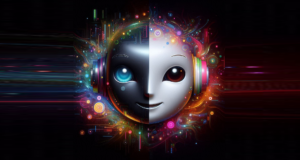Generative AI, or “GenAI,” is a kind of artificial intelligence that generates content—data, text, images, code—based on natural language prompts. The original, case-specific output of this kind of AI has massive potential across sectors to streamline processes that otherwise require significant intellectual or physical labor. It also has the potential to forge discovery of entirely new solutions beyond the realm of human logic.
In Mind Moves’ “Imagine” series, we ask you to imagine how AI can transform industry, both incrementally and fundamentally, by providing new solutions to old problems. What does this transformation mean for us, our everyday humanness? In this first edition, we’ll dive into the industry of healthcare and medicine.
How Can GenAI Improve the Healthcare Experience?
Currently, the United States is experiencing a staffing shortage in the healthcare industry. In times like these AI can supplement the patient experience and lessen the load for providers. But, even in times of abundant staffing, GenAI can play a vital role in a patient’s care. This can take place in the form of automated chatbots that communicate with patients before a provider, in order to gather patient data in an expedient way, making the visit that much more seamless. This is achievable with the help of Large Language Models, or LLMs, which are AI models trained on large amounts of human language data. LLMs make it possible for complex language to be parsed, classified, and communicated to a patient’s healthcare team, ultimately delivering a higher standard of care.
GenAI Is also effective at real-time translation, meaning that an AI-smart hospital would be safer, more efficient, and have fewer communication breakdowns. Additionally, patients who might usually experience degrees of discrimination or bias due to human error can have their experiences recorded in an objective, non-judgmental way. In the future, we should be ready for audio-enabled devices to listen to our conversations. To some, this could feel like a privacy concern. The same concern was expressed for telehealth platforms, which have now become a time-saving staple of care. Maintaining an openness around technological culture shifts will allow for healthcare to innovate in a positive way, creating a net benefit for both the patient and provider.
Integrative Uses
Beyond patient interface, GenAI has massive potential for the healthcare industry. Normally, access to patient data is limited due to privacy issues, but with the help of AI, patient data can be synthesized incognito or augmented using synthetic data. This unidentified data can then be used to train both new and established healthcare providers to recognize a variety of conditions across a range of patient demographics. This technology is helpful, not just in language form, but in image form as well, meaning that scans can also be generated for the purpose of helping radiologists develop a keener eye.
But GenAI has a bigger role in radiology besides just training. As a field that requires keen attention to detail and consistent generation of long reports, professionals can often fall victim to burnout. This jeopardizes the quality of patient care and leaves hospitals open to liability. Luckily, AI with a high degree of sensitivity has been developed to help analyze scans and generate corresponding reports. And, when tested, studies have shown that radiologists equipped with AI perform better than without it, leading to faster care of the highest standard. For more on AI-powered radiology, in an episode of The AI Podcast, Dr. Keith Channon talks about AI’s ability to discover heart inflammation on CT scans.
Efficient Administration
GenAI has the capability to reduce the workload across the healthcare sector, but LLMs can have a profound, sweeping impact by transforming the way administrative tasks are performed. For patients, this can mean faster insurance claim approval. Normally, designated claim departments can take weeks to review and deliver a decision, but with the power of AI, large amounts of language information can be processed at a rapid rate, meaning that prior authorizations and other claims can be expedited in order to close gaps in care. While there will still be a role for in-person interactions, especially in the appeals process, in straightforward cases, AI can expedite an update in status. AI chatbots are already in use in the health insurance industry, but their capabilities can be limited. Adoption of more complex language models can help elevate the patient experience.
In hospitals and medical practices, providers can use Gen AI to deliver quick, accurate and detailed information to patients such as drug facts and post-visit instructions, both educating and empowering them. It might also be used to communicate information about a patient within a practice through generated reports, especially in routine cases.
Drug Discovery
GenAI has an opportunity to make a lasting and transformative mark in the field of drug discovery, and this potential is twofold: first, in streamlining essential document generation in the establishment of new clinical trials, and secondly, as a tool in research. Hundreds of thousands of new clinical trials are introduced each year, but only 7% of them go on to become successful. This means that while we have an abundance of ideas, we still need more. AI can help aid in the establishment of life-saving clinical trials by helping to expedite the lengthy documentation process. With current LLMs’ capability to generate complex scientific writing, the time between a drug’s inception and its implementation could be significantly reduced.
Finally, GenAI shows promising results in the scientific process of drug discovery. Recently, in 2023, researchers implemented AI to discover a new kind of antibiotic with the ability to fight previously antibiotic-resistant bacteria. With AI’s ability to generate biochemical configurations not otherwise imagined, its use is sure to become standard in the field of microbiology, creating an exciting and hopeful horizon for the future of medicine.
Conclusion
In the sprawling healthcare sector, GenAI is emerging not just as a solution to old problems, but as an innovative tool to change healthcare and medicine for the better, enhancing both efficiency and accuracy to provide better patient outcomes. At its fullest potential, GenAI can help us blend human expertise and artificial ingenuity to imagine a healthcare landscape that is patient-centric, administratively streamlined, and at the forefront of medical innovation.





